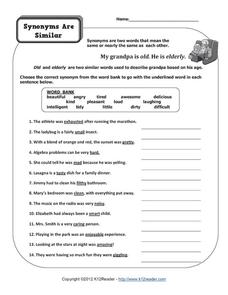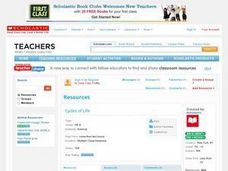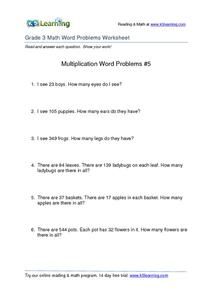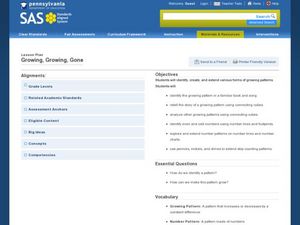Cornell University
Too Much of a Good Thing?
Continuing their study of beneficial insects, young entomologists discover where in the world some of these bugs are. By labeling, coloring, and using the scale on a map, pupils explore the territories and arrival of the Asian lady...
American Museum of Natural History
What's This? Colorful Creatures
An online resource shows learners some species that are very good at using their camouflage as well as other ways species use their coloring for survival. Interactive and digital, the lesson is perfect as a remote learning resource.
K12 Reader
Synonyms Are Similar
Kids select a word from the provided bank that is similar in meaning to the underlined word in 14 sentences.
Curated OER
2nd Grade - Act. 04: What Time Is It?
How do you teach time? Using various stories, 2nd graders will learn about the concept of a daily schedule to develop a sense of self. They will complete a time of day chart and learn about the basic concepts of time beyond a minute....
Curated OER
Cycles of Life
Students explore the metamorphosis of an insect as it changes from an egg to pupa to an adult. the process of change is observed, recorded, and transformed into a life cycle picture.
Curated OER
Introduce Vocabulary: Have You Seen Bugs? (Oppenheim)
Are your scholars interested in bugs? Get future entomologists excited about vocabulary through Joanne Oppenheim's colorful book Have You Seen Bugs? They use the informational text (although this strategy is useful for any book) to...
Curated OER
Introduce Vocabulary: Red Riding Hood (Marshall)
It's the classic story of Little Red Riding Hood retold by James Marshall; scholars listen for six new words as you read: bouquet, charming, escort, horrid, tarry, and wicked. Introduce the words before reading so they can...
Curated OER
Complete Novel Guide: James and the Giant Peach
Before your class reads the book James and the Giant Peach, check out this very handy set of learning activities. The reading guide provides you with several excellent ideas for building vocabulary related to the text and reading...
Busch Gardens
Create an Invertebrate
What better way for young biologists to learn about invertebrates than by creating their very own? Here, students are assigned a set of invertebrate characteristics and are asked to invent an imaginary ocean animal...
Lakeshore Learning
Alphabet Sounds Teaching Tubs
A hands-on activity brings the alphabet to life in your kindergarten! Fill tubs with items that begin with the same letter or end with the same sound, and let kids make the connections between the items.
American Museum of Natural History
What's the Big Idea About Genetics?
Here's a quick read on genetics. An engaging online resource provides six slides of information about genetics. Learners read about the meaning of genetics to information about DNA. They also learn about the study of genes and the...
Teacher Writing Center
Spring Lesson
Ring in the spring with a study of adverbs. These spring worksheets cover when and how to use adverbs, provide plenty of adverbs to try out, and use images of spring as inspiration for students to tap into as they write original sentences.
Curated OER
Sorting the Animals
Does a fish have four legs? Of course not! Youngsters practice their counting (and animal attributes) skills as they determine which of each set of animals has a specified number of legs. They circle animals with four, six, two, and zero...
DK Publishing
Which Has More?
Reinforce more than and less than with beads, bricks, and bugs. Youngsters will love counting and choosing the picture with more than the other. Numbers 1 - 10 are printed across the bottom of the page so that they can be referred to...
Curated OER
Dinnertime for Animals
Is a deer an herbivore? What about a spider? Experiment with the food chain in an interactive science experiment. After listing the herbivores from a selection of animals, third and fourth graders compare the skulls and teeth of...
Curated OER
'Don't Let the Bugs Bite' Challenge
In this insect facts worksheet, students respond to 11 multiple choice questions that require them to exhibit what they know about insects.
K5 Learning
Multiplication Word Problems #5
How many legs to 349 frogs have? How many ears are on 105 puppies? These and other fun multiplication word problems will have learners applying their math skills to realistic scenarios using two- and three-digit multiplication.
Pennsylvania Department of Education
Shapes Around Us
Learners use manipulatives to study shapes. They sort shapes and use correct geometric terminology to describe them. Students find real-life examples of 2 and 3 dimensional shapes, and classify figures in their classroom according to...
Curated OER
My Own Backyard
Scholars create a drawing of their own backyards. They will use a visualization technique to sketch their own backyard onto construction paper using oil pastels. Guiding questions are given along with materials for the project....
Curated OER
'Don't Let the Bugs Bite' Word Search
In this bugs word search learning exercise, learners locate and identify 25 insect-related words within the word search puzzle.
Curated OER
'Don't Let the Bugs Bite' Vocabulary
In this bug vocabulary skills worksheet, students match the 12 listed insects to the appropriate sentences that describe each of them.
Granite School District
Types of Ratios
Ratios can be written in a number of ways including whole to part, part to part, part to whole. For each problem, young mathematicians write the given ratio and classify it based on those categories.
Curated OER
Growing, Growing, Gone
Budding mathematicians identify growing patterns in numbers and songs then create their own patterns. They look at number patterns and language patterns and then create their own using money and footprints.
Curated OER
Counting Back and Counting On
Read aloud your choice of books about counting on and counting back (a list is provided, or tell stories of your own). Your learners will write horizontal equations to portray what happens in the story. They build a paper chain and...
Other popular searches
- Ten Little Ladybugs
- Ladybugs Math Activities
- Ladybugs and Social Studies
- Life Cycle of Ladybugs
- Preschool Ladybugs
- 10 Little Ladybugs
- Language Arts and Ladybugs
- Reading, Ladybugs
- Ladybugs Craft
- Animals: Ladybugs
- Ten Little Ladybugs Addition
- Ladybugs Communication























